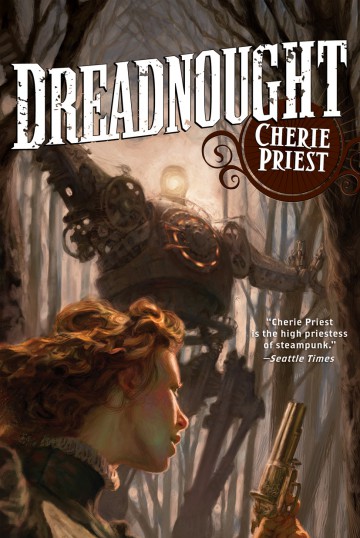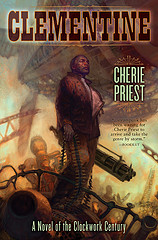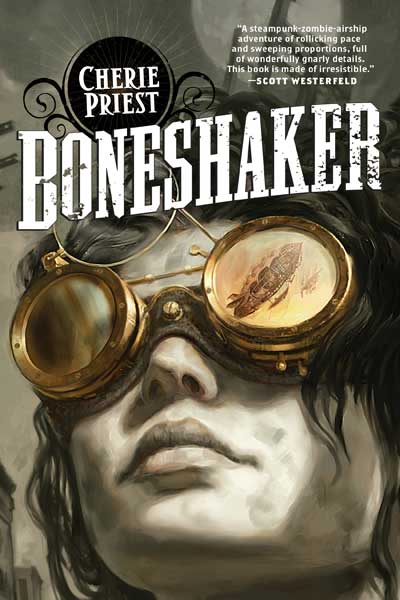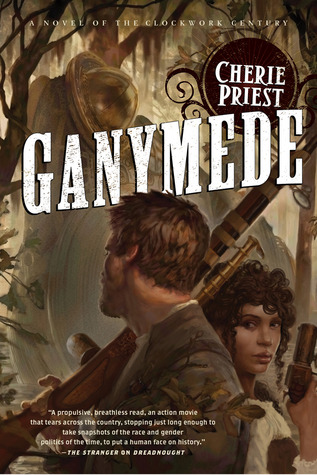When Cherie Priest entered the steampunk scene years ago, she stumbled upon some comments on a message board declaring that American steampunk wasn’t really steampunk, since it had to be based in Victorian England. Priest, who had one more book under contract with Tor Books at the time, saw this as a challenge. Thus, Boneshaker, the first in her Clockwork Century series, was born.
Who knew that an attempt to squish some internet forum posturing would end up as a three book (and one novella) ongoing series, with nods for both the Hugo and the Nebula and wins from the PNBA and Locus Magazine for Best Science Fiction Novel? Not to mention that many consider Boneshaker to be the watershed novel marking the popular rise of the steampunk subgenre in SFF.
What is it about Priest’s Clockwork Century series that makes it stand out? Well, you can start by reading the reviews on Tor.com: Boneshaker, Dreadnought, Ganymede, and Clementine (the novella). After the jump, I’ll get more in-depth about various aspects that keep me reading. And to note: as with all versions (or re-imaginings) of history, it’s not perfect. Don’t get me wrong, I highly enjoy the Clockwork Century books and I’ll continue to follow them. But this is an appreciation, and one can’t truly appreciate anything without acknowledging both its strengths and its weaknesses.
 Lost & Found: Recognizing Histories
Lost & Found: Recognizing Histories
Boneshaker opens up with the arrival of historian Hale Quarter to the outskirts of walled-up Seattle. He’s there looking to record the truth about the frontier town. Though he doesn’t play a large role in the first book and doesn’t show up in later volumes, Quarter’s appearance establishes a theme that continues through the series—finding people and recognizing their place in history. And not just the crazy, messed up alt hist of Priest’s world, but placing actual people in our real history books—the figures that had been obscured, lost, or forgotten over time.
Lost places and contraptions are obvious examples of what makes her steampunk books so much fun. The underground tunnels of Seattle (based on the actual underground city), for example, is Priest’s biggest accomplishment. Railroad technology and dirigibles are obvious examples of other tech that is appreciated in these books, and the Civil-War era submarines that inspired Ganymede is another.
Not only are obscure places recognized, but so are the people that have been lost in mainstream historical tales. Marginalized groups in particular are fully integrated as part of the American landscape of the Clockwork Century. The presence of people of color is more than tokenism, but actually meaningful and relevant to her storylines. Princess Angeline, for instance, the daughter of the deceased Native chief Seattle, takes revenge against the villain of Boneshaker as the man who had wronged her daughter. Black entrepreneurs like Mrs. Hyde in Dreadnought become wealthy restaurant owners (albeit, serving meals in segregated dining rooms), and international politics are worked into that same novel with the arrival of Mexican inspectors Galaeno and Portilla. Queer folk also get a nod (though I’d like to see more in the future); Ruthie, Josephine Early’s right-hand gal in Ganymede is transgender. Refreshingly enough, there is no angst or blackmailing subplot involved with her identity whatsoever. Ruthie is just Ruthie.
In addition, the question of what to do with Asian immigrants becomes relevant in Dreadnought with the Union’s attempt to recruit Chinese settlers out west. On the other hand, in Ganymede, Yaozu wants to keep the zombie-infested city of Seattle alive because it’s one of the few places where he thinks the Chinese community can prosper free from discrimination (but having that prosperity fueled by running yellow sap is another story…)
For all of her inclusiveness, however, I’d like Priest to go further with her characters of color other than having others say how awesome they are. Huey, despite his pluck, is a bit of a one-note, cast as the boy genius without having the opportunity to fully show off that genius or anything else. Princess Angeline pretty much is a wandering Native after slitting Minnericht’s throat and I want her to be more than that. This is why I appreciate Josephine Early and her ladies so much, since they feel the most fully formed and significant PoCs yet in her series (I haven’t read Clementine in full yet, so I’m not dismissing Hainey’s characterization, by the way).

The Civil War as the War that Never Ended
Along with putting the forgotten back into history, Priest explores the consequences of an extended American Civil War. This is tricky territory.
Throughout the books, characters are frustrated about the general horribleness of an ongoing war, and the reason for its continuation stems from a variety of reasons. The Republic of Texas is fueling the South with technology and money for its own self-interest. The British are somehow helping the South, too. Stonewall Jackson didn’t die in the Battle of Chancellorsville, keeping the Confederate leadership strong. And, despite all of these Southern advantages, the North keeps trudging on, under the assumption by many the characters that the Northerners have an endless source of men and resources. (Which, actually, they don’t.)
In light of this ongoing war, Priest makes the choice of abolishing slavery in most of the Southern states for practical reasons (it was more efficient to have their white Southerners fight for the army than spend resources maintaining a slave-based economy). Cue the “fighting for state’s rights” flag. That reason, if it was stated by itself would make me give the whole series the squint-eye. Yet in the books, “state’s rights” doesn’t gloss over the fact that Confederates did start the war over the Peculiar Institution: in fact, from the perspective of her black and mixed-race characters, of course it was all about state’s rights—the right to own other people.
I can’t imagine the newly freed black population choosing to fight for the South even in this alternate history scenario, too, and I’m glad that Priest does not go there. I tend to believe this scenario of perpetual total war justifies that reason to be more legitimate than apologist.
More importantly, she addresses the moral and social complexities many people face in this world. In Dreadnought for example, Mercy Lynch’s husband fought for the Union and died in a POW camp while she ends up serving at a Southern soldier’s hospital. One of the tensions in the novel is about Mercy hiding her past of questionable alliances while riding the Union train. In another instance of conflicting loyalties, New Orleans is occupied by their Texan allies in Ganymede, but it doesn’t mean that the residents of the Big Easy actually want them there. The runaway slave Croggin Hainey faces his worst fears about returning to the Deep South in Clementine. Many of the black characters in Ganymede express a lingering fear of being mistaken for runaways and being taken back to the plantations, making the tensions between free blacks and the Confederate army a believable reality.
The only regional viewpoint that I’m especially intrigued to see is the North’s. Priest, being originally from the South, certainly shows her bias, but with all of the Southerners and frontier folk crying out for the war to end, the lack of a Northern viewpoint is glaring. I’m only hoping that we’d get a perspective from them somehow in the future.

Steampunk Feminism? The Progression of Female Leads in the Clockwork Century
Boneshaker had garnered a lot of praise for its protagonist Briar Wilkes, a middle-aged, working-class single mother. In fact, the female leads in all of the three major novels are older, tougher and grittier than your usual ladies of SFF. Briar, Mercy, and Josephine have much to be admired (note: I’m leaving out Maria Isabella Boyd of Clementine for now since I’m not as familiar with the novella). For the first two ladies at least, I never fully believed them to be as strong as they could’ve been, and mostly it’s because of the relationships they have to the men in the lives.
Briar is the worst example of the three. She is emotionally haunted by the memories of her dead husband and father. Her relationship to her son Zeke is also distant and estranged, and it is mostly guilt about being a bad mother that drives her to find him. Having dysfunctional relationships with men does not make a woman a more feminist character. In fact, the overpowering influence they have in stunting her emotional growth is very disconcerting. In the end, Briar becomes the sheriff of Seattle, but even that honor is made under the shadow of her much-respected father.
Mercy is a tough, practical-minded nurse who dares to travel alone across the country, a big feat for a woman of her time. On the other hand though, the motive behind her travels is to find a father who left her family when she was a child and for whom she felt no emotional attachment to until she discovered that her husband had died. Now that one male figure is gone from her life, it seems, she feels obligated to find another, even if that person is a near-stranger.
 Josephine, luckily, breaks away from this pattern of having men being emotional beacons. Sure, she and Andan had a thing in the past, but that was all past (and, interestingly enough, he lingers over it more than she does). Sure, she has her brother Deaderick, but instead of being hampered by guilt to run after him like Briar does for Zeke, she watches out for him because they have always watched out for each other. Props to mutual love and respect in the family! Additionally, she has a much stronger network of supportive relationships with the women in her life, another refreshing aspect to her character.
Josephine, luckily, breaks away from this pattern of having men being emotional beacons. Sure, she and Andan had a thing in the past, but that was all past (and, interestingly enough, he lingers over it more than she does). Sure, she has her brother Deaderick, but instead of being hampered by guilt to run after him like Briar does for Zeke, she watches out for him because they have always watched out for each other. Props to mutual love and respect in the family! Additionally, she has a much stronger network of supportive relationships with the women in her life, another refreshing aspect to her character.
Conclusion: How to Build a Better Pulp
Besides all of the factors that make the Clockwork Century series worth reading, there is the overall style of the books. Priest’s writing style is cinematic and her characters’ gestures are stylized to be slightly larger-than-life but still relatable. She takes SFF standards (zombies, post-apoc, alternate history) and combines them into something innovative and new. The success of her books has also contributed to the current trend of incorporating more supernatural elements into steampunk lit.
I’d also actually go as far to say that her books read like traditional pulp fiction that reflects modern values. The books are fun, action-packed, and fast-paced but without the problematic baggage that the historical pulps had. Ultimately, Priest takes the best of the old and presents it for today’s world, and that attitude, more than anything else, is what makes the Clockwork Century so steampunk.
Ay-leen the Peacemaker runs Tor.com Steampunk on Facebook and Twitter and the multicultural steampunk blog Beyond Victoriana.









